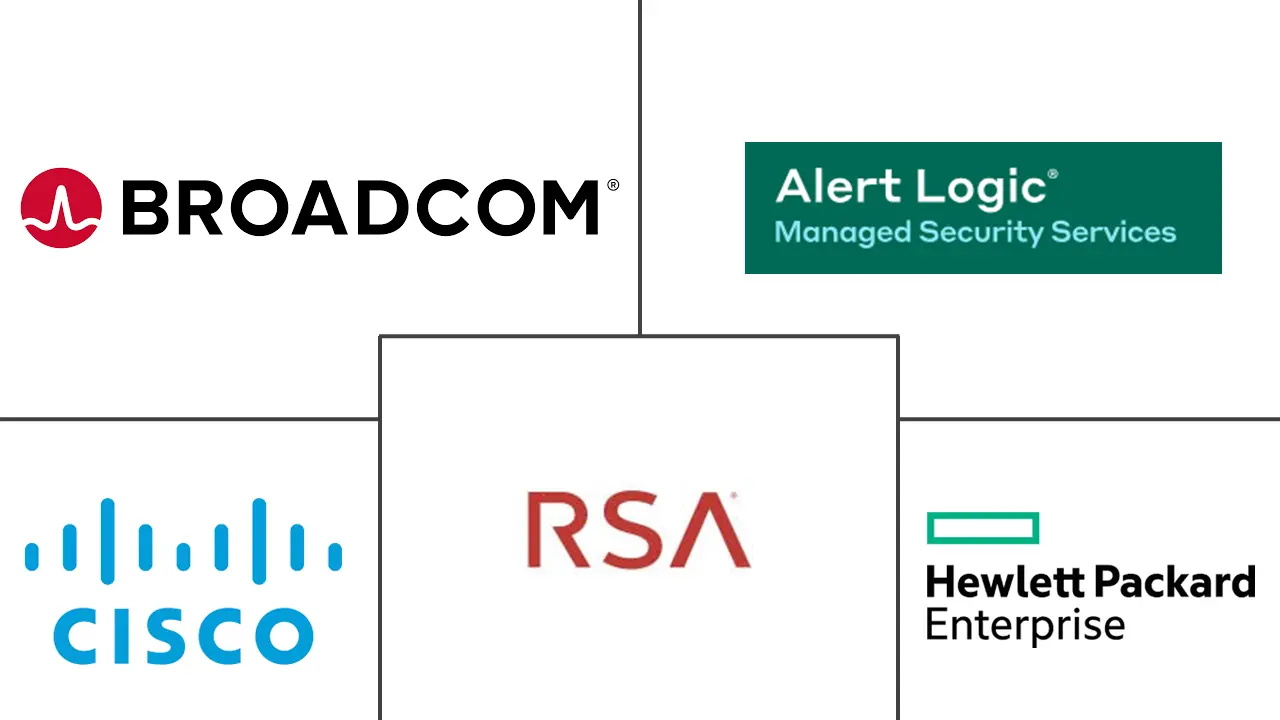Security Analytics Market Size and Share
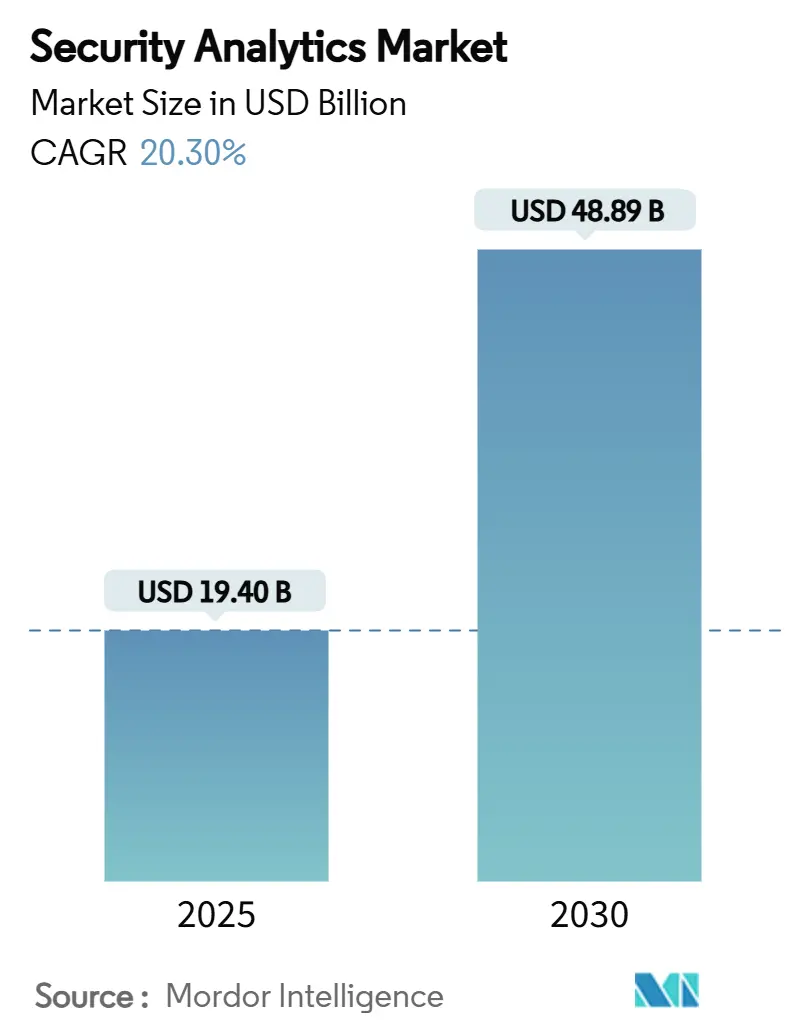
Security Analytics Market Analysis by Mordor Intelligence
The security analytics market is valued at USD 19.40 billion in 2025 and is forecast to touch USD 48.89 billion by 2030, advancing at a CAGR of 20.30%. The surge reflects enterprises’ drive to neutralize sophisticated cyber-attacks with AI-led platforms that analyze billions of events in real time. Growth stems from an explosion of IoT endpoints, cloud-first transformation projects, and tightening compliance regimes that require automated analytics. Demand is further amplified by platform consolidation: large vendors now bundle SIEM, SOAR, UEBA, and threat-intelligence into single suites to simplify operations and counter tool sprawl. CrowdStrike, Palo Alto Networks, Microsoft, IBM, and Cisco compete aggressively on analytics breadth, speed, and native automation while niche specialists maintain traction through differentiated AI models and cloud-native architectures.
Key Report Takeaways
- By application, network security analytics led with 38% of security analytics market share in 2024; cloud security analytics is projected to grow at 17.6% CAGR through 2030.
- By deployment, on-premise models held 54.5% share of the security analytics market size in 2024, while cloud deployment is slated to expand at 21% CAGR to 2030.
- By organization size, large enterprises accounted for 69% of revenue in 2024, whereas small and medium enterprises are set to grow at 16% CAGR through 2030.
- By end-user, banking and financial services captured 28.5% of the security analytics market share in 2024; healthcare will accelerate at 16.6% CAGR to 2030.
- By geography, North America retained 42% revenue share in 2024; Asia-Pacific is forecast to register a 13.8% CAGR by 2030.
Global Security Analytics Market Trends and Insights
Drivers Impact Analysis
| Driver | (~) % Impact on CAGR Forecast | Geographic Relevance | Impact Timeline |
|---|---|---|---|
| Sophistication of cyber-threat landscape | +4.2% | Global, with heightened impact in North America and EU | Medium term (2-4 years) |
| Explosive growth of IoT and BYOD endpoints | +3.8% | Asia-Pacific core, spill-over to North America and EU | Long term (≥ 4 years) |
| Cloud-first digital-transformation programs | +5.1% | Global, led by North America and EU, accelerating in Asia-Pacific | Short term (≤ 2 years) |
| Expanding global cybersecurity-compliance regimes | +3.4% | EU and North America primary, extending to Asia-Pacific and MEA | Medium term (2-4 years) |
| AI-driven polymorphic malware emergence | +2.7% | Global, concentrated in developed markets initially | Medium term (2-4 years) |
| Surge in unmanaged machine-to-machine identities | +2.9% | Global, particularly in manufacturing and IoT-heavy sectors | Long term (≥ 4 years) |
| Source: Mordor Intelligence | |||
Sophistication of cyber-threat landscape
Nation-state actors now deploy automated toolchains that evade signature-based defenses, pushing enterprises toward behavioral analytics that detect lateral movement and zero-day exploits. The FBI cited a spike in state-sponsored attacks on telecom carriers aimed at surveillance and data exfiltration. [1]RSM US, “Nation-State Threat Landscape,” rsmus.comSecurity teams therefore favor platforms with machine-learning models that self-learn network baselines and flag anomalous paths in milliseconds. Vendors integrate UEBA and threat-intel feeds directly into SIEM engines, shrinking dwell time and improving mean time to detect. This arms race rewards suppliers able to retrain models continuously without manual feature engineering.
Explosive growth of IoT and BYOD endpoints
Industrial sensors, medical devices, and remote-work laptops have swollen the attack surface, leaving perimeter controls ineffective. Research in Scientific Reports found that more than 60% of organizations suffered insider threats tied to unmanaged devices. [2]Scientific Reports, “Behavioral Analysis of Insider Threats,” nature.com Modern analytics ingest telemetry from OT gateways, mobile EDR agents, and edge nodes, applying unsupervised learning to classify device behaviors. Edge processing cuts latency and keeps operations running when connectivity drops. Vendors now embed lightweight agents in firmware and combine them with cloud-side graph analytics to correlate anomalies across fleets of millions of endpoints.
Cloud-first digital-transformation programs
Lift-and-shift strategies and green-field SaaS adoption accelerate the pivot from on-prem SIEM to cloud-delivered analytics. The AT&T–Palo Alto Networks collaboration bundles connectivity with real-time threat detection inside a unified SASE fabric. [3]AT&T, “AT&T and Palo Alto Networks Deliver SASE,” att.com Cloud-native platforms elastically scale log ingestion and run AI models without customer hardware, enabling continuous inspection across AWS, Azure, and Google Cloud. Serverless and container workloads add new telemetry types—API calls, sidecar communications, and cold-start logs—that require purpose-built data collectors and context enrichment at ingest.
Expanding global cybersecurity-compliance regimes
The EU Cyber Resilience Act obliges manufacturers to patch connected devices throughout their lifecycle, driving demand for analytics that confirm vulnerability remediation. [4]Secure Privacy, “EU Cyber Resilience Act Overview,” secureprivacy.ai Financial regulators now insist on live anomaly detection for fraud, making advanced analytics unavoidable in banking stacks. GDPR’s extraterritorial scope forces granular audit trails and orchestrated data-subject-access reporting, so vendors bake compliance modules and automated evidence generation into dashboards. As mandates proliferate across healthcare, telecom, and critical infrastructure, buyers prefer platforms that map detections directly to frameworks such as NIS2, ISO 27001, and HIPAA.
Restraints Impact Analysis
| Restraint | (~) % Impact on CAGR Forecast | Geographic Relevance | Impact Timeline |
|---|---|---|---|
| Data-integration and tool-sprawl challenges | -2.8% | Global, particularly acute in large enterprises | Short term (≤ 2 years) |
| Global shortage of SOC analysts | -3.1% | Global, most severe in North America and EU | Medium term (2-4 years) |
| High alert-fatigue and false-positive rates | -2.4% | Global, concentrated in mature markets | Short term (≤ 2 years) |
| Data-sovereignty rules restricting analytics | -1.9% | EU primary, extending to Asia-Pacific and emerging markets | Long term (≥ 4 years) |
| Source: Mordor Intelligence | |||
Data-integration and tool-sprawl challenges
Most enterprises juggle 25–50 security tools that emit disjointed log schemas, forcing custom parsers and delaying correlation. CSO Online reports that integration overhead drains analyst capacity and obscures cross-vector attacks. Buyers are replacing point solutions with converged analytics suites, yet fear of vendor lock-in slows rip-and-replace projects. As cloud migration compounds complexity, platforms must normalize on-prem Syslog, cloud API metadata, and SaaS audit trails within a single data lake, or risk perpetuating silos.
Global shortage of SOC analysts
ISC² estimates a workforce gap of 4 million practitioners, leaving many security analytics deployments underutilized. TechXplore highlights that advanced threat-hunting skills are especially scarce, prolonging incident response and inflating managed-service costs. Vendors counter with autonomous triage, natural-language playbooks, and AI-generated forensic narratives, but buyers still need personnel to validate alerts and tune models. SMEs feel the crunch most acutely, steering them toward outsourced MDR and fully managed XDR offerings.
Segment Analysis
By Application: Network Security Dominates Traditional Infrastructure
Network security analytics generated 38% of 2024 revenue, underscoring the enduring role of deep-packet inspection and NetFlow analysis in the security analytics market. Cloud security analytics is advancing at 17.6% CAGR to 2030 as enterprises shift workloads off-premises and seek cross-cloud visibility. Application, web, and endpoint analytics together broaden detection coverage, while insider-threat modules employ UEBA to profile user behavior.
The convergence of these sub-segments pushes vendors to embed microservices-based collectors that ingest diverse telemetry into unified data fabrics. Platforms offering AI-driven policy recommendations and automated remediation now achieve a 59% drop in false positives versus legacy rule engines. Integrated suites therefore appeal to security leaders aiming to slash alert noise while protecting network, application, and identity layers in one console.
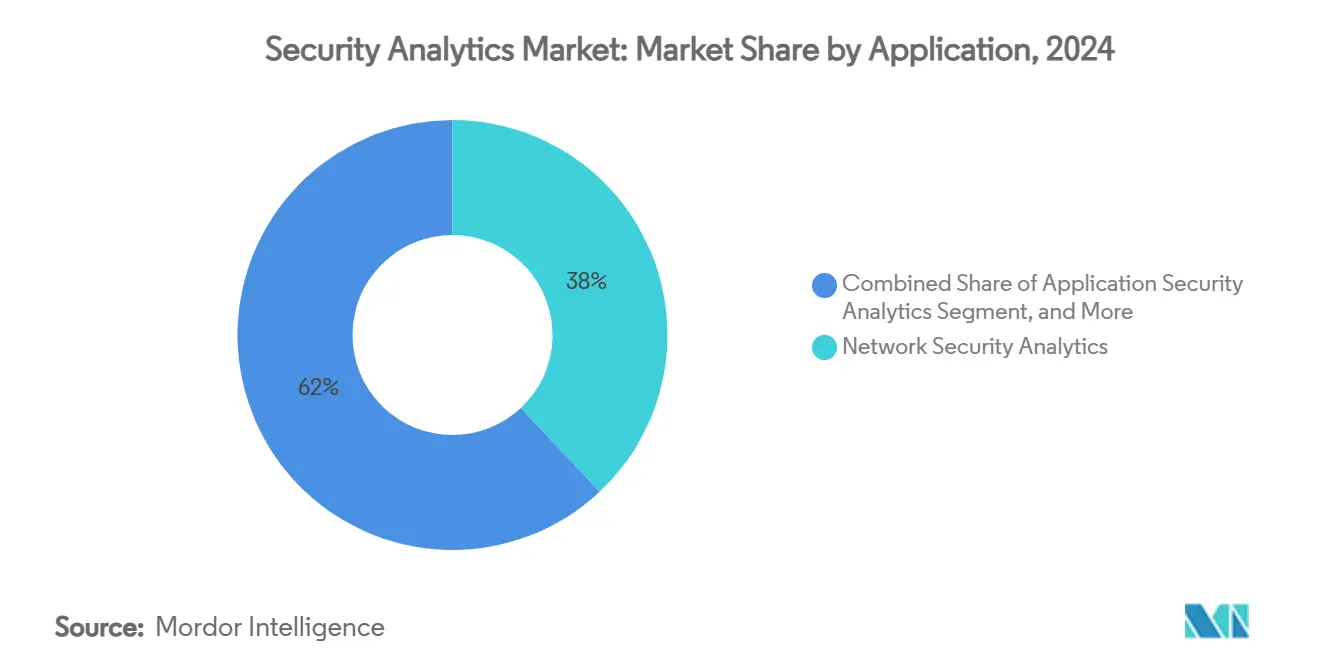
Note: Segment shares of all individual segments available upon report purchase
By Deployment Mode: Cloud Transformation Accelerates
On-premise implementations held 54.5% revenue in 2024, reflecting sunk investments and sovereign-data rules that keep sensitive logs inside firewalls. Yet the security analytics market size for cloud deployments is forecast to expand at a 21% CAGR through 2030 as firms adopt SASE and zero-trust mandates. Hybrid models are emerging as a pragmatic bridge—critical logs remain local while burst analysis occurs in secure clouds.
The U.S. Department of Defense’s Zero Trust Architecture 2.0 targets full coverage by 2027, leaning on commercial cloud analytics for scalability. Consumption-based licensing and managed ingestion pipelines erase capital expenditure hurdles, enticing even regulated industries to offload compute-intensive correlation tasks. Vendors also deploy regional cloud “cells” to meet data-residency directives without sacrificing analytic depth.
By Organization Size: SME Adoption Drives Growth
Large enterprises comprised 69% of sector value in 2024, but SMEs will propel incremental growth at 16% CAGR. Cloud-delivered analytics democratize tooling by bundling sensors, storage, and machine learning into subscription tiers accessible to lean IT teams. Techaisle notes that 21% of high-growth SMEs planned ≥15% budget hikes for cybersecurity in 2025.
Managed detection and response services top SME wish-lists because they remove the need for 24×7 SOC staffing. European vendors such as WithSecure now tailor AI-assisted threat-hunting packages to mid-market buyers concerned with local data privacy requirements. As a result, suppliers compete on automated investigations, intuitive UIs, and fixed-fee offerings aligned to SME cash-flow constraints.
By End-user Industry: Financial Services Lead, Healthcare Accelerates
Banking and financial services captured 28.5% of the security analytics market in 2024, driven by real-time fraud mandates and high breach remediation costs. Healthcare is fastest at 16.6% CAGR as ransomware targets electronic health records and patient-care continuity. IBM’s Cost of a Data Breach study shows healthcare breach expenses averaging USD 4.88 million, nudging providers toward AI-driven anomaly detection.
Manufacturing now ranks second in attack volume, motivating investments in OT security analytics that map industrial protocols and detect suspicious command bursts. Government, telecom, and retail domains likewise accelerate adoption to meet zero-trust executive orders, 5G core protection, and omnichannel fraud prevention, respectively.
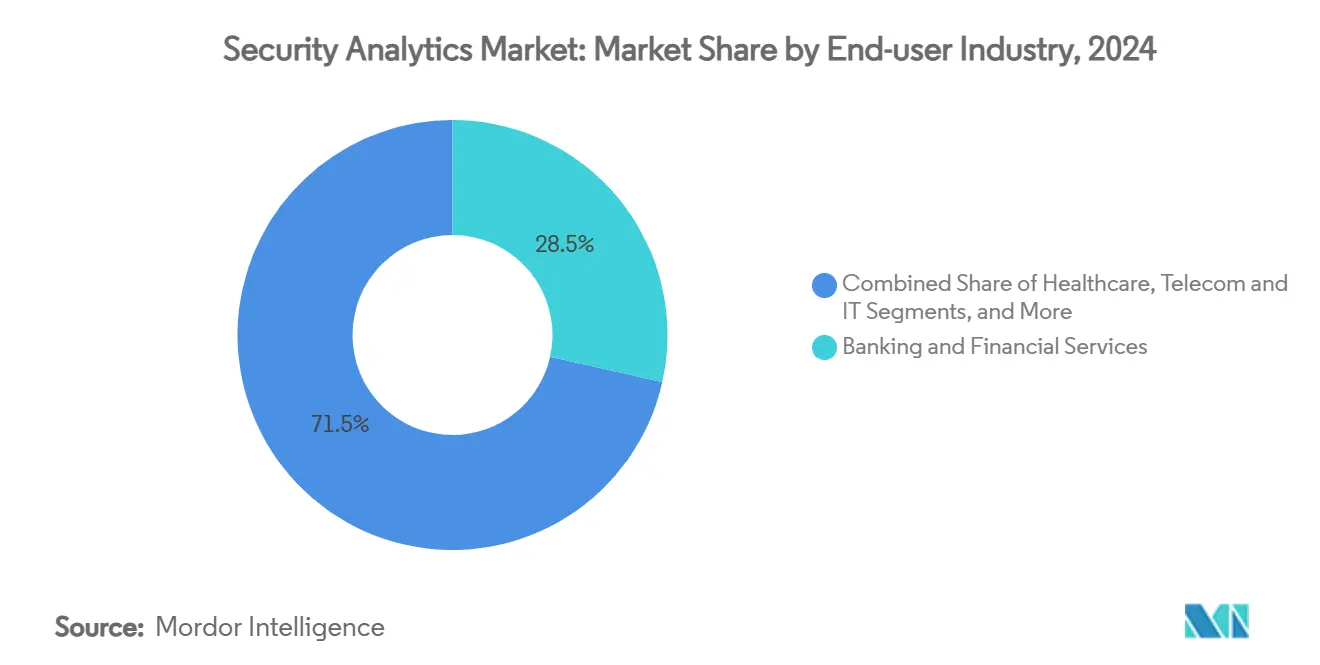
Note: Segment shares of all individual segments available upon report purchase
By Organization Size: SMEs Challenge Enterprise Dominance
Large enterprises contributed 58.8% of 2024 revenue, leveraging complex toolchains and sizeable budgets. SMEs, though, are scaling adoption faster at 21.2% CAGR, benefiting from subscription-based cloud platforms that remove capital barriers. Simplified onboarding workflows and prescriptive analytics dashboards allow smaller teams to act swiftly on prioritized alerts.
As vendors adapt feature sets and pricing to mid-market needs, the security analytics market is likely to experience wider geographic and vertical diffusion, enhancing overall market resilience.
Geography Analysis
North America commanded 42% revenue in 2024, benefitting from sizable cyber-budgets and early uptake of AI-enhanced SIEM. Federal directives such as Executive Order 14028 force continuous diagnostics and disclosure, further fueling spend.
Asia-Pacific is projected to grow at 13.8% CAGR, propelled by cloud migrations, cyber-insurance penetration jumps, and government-backed digital programs. Gallagher Re reports Asia-Pacific cyber-insurance premiums climbing nearly 50% annually. Australia, Singapore, Japan, and South Korea spearhead spending, yet India and China add the largest volume of new deployments as domestic tech champions scale globally.
Latin America eyes 64% IT-budget expansion for 2025, prioritizing analytics that handle a region-wide average of 1,600 attacks per second. EMEA growth remains steady; Europe leans on GDPR and the forthcoming Cyber Resilience Act, while Middle East and North Africa security outlays are set to exceed USD 3 billion in 2025, spurred by AI adoption in oil, gas, and government sectors.
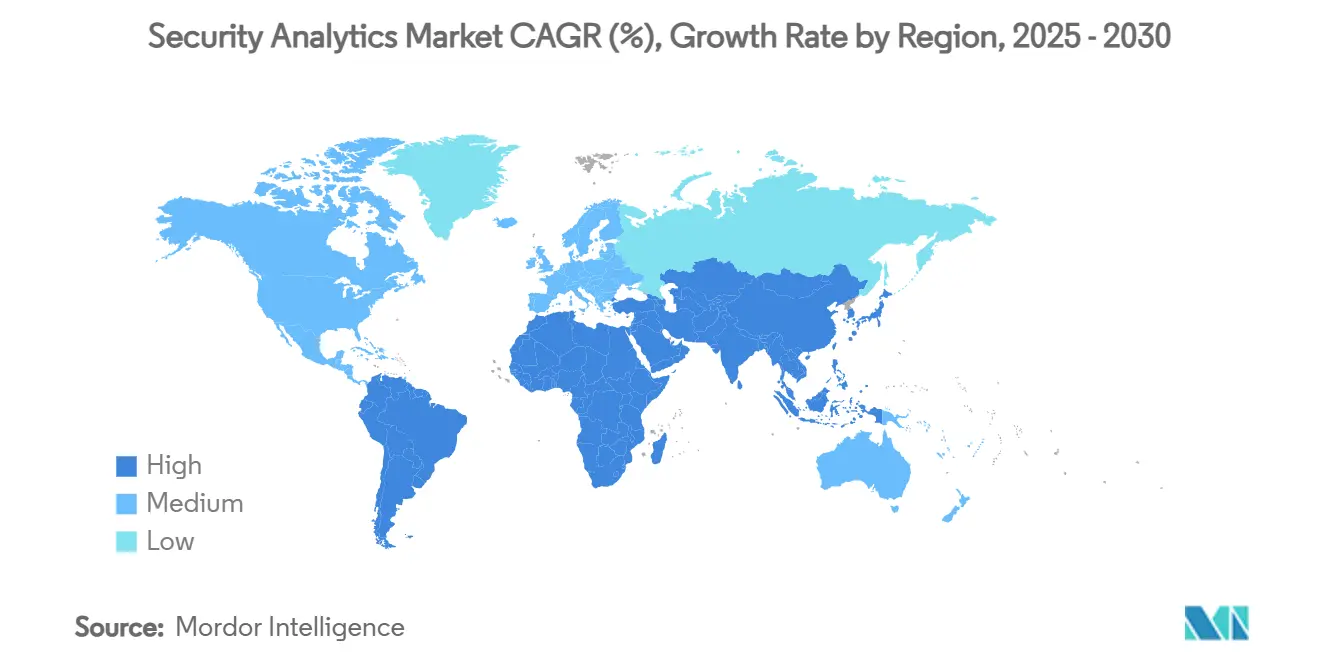
Competitive Landscape
The security analytics market sits in moderate consolidation. The top five suppliers—Microsoft, Palo Alto Networks, IBM, Cisco (post-Splunk), and CrowdStrike hold a significant share, while dozens of challengers innovate in niche functions. Palo Alto Networks recorded USD 4.8 billion in next-generation security ARR on 15% growth, crediting its platform strategy. Cisco’s acquisition of Splunk lifted its security revenue 117% to USD 2.1 billion by integrating SIEM telemetry into SecureX.
Google’s proposed USD 32 billion purchase of Wiz underscores hyperscale appetite for cloud-centric analytics. Microsoft continued M&A by absorbing RiskIQ for USD 500 million, adding external-attack-surface mapping to its Sentinel SIEM.
Emerging rivals differentiate through graph databases, LLM-based playbook generation, and privacy-preserving edge analytics. QOMPLX patents on distributed graph computation accelerate risk scoring by 7.4× while shrinking storage. CrowdStrike’s GraphWeaver technology claims 99% alert correlation accuracy across petabyte-scale datasets. Vendors now publicize ROI metrics—mean-time-to-respond reductions and analyst-hour savings—to court CFO scrutiny and win displacements of legacy SIEM.
Security Analytics Industry Leaders
-
Alert Logic, Inc.
-
Broadcom Inc. (Symantec Enterprise Division)
-
Cisco Systems, Inc.
-
RSA Security LLC
-
Hewlett Packard Enterprise Company
- *Disclaimer: Major Players sorted in no particular order
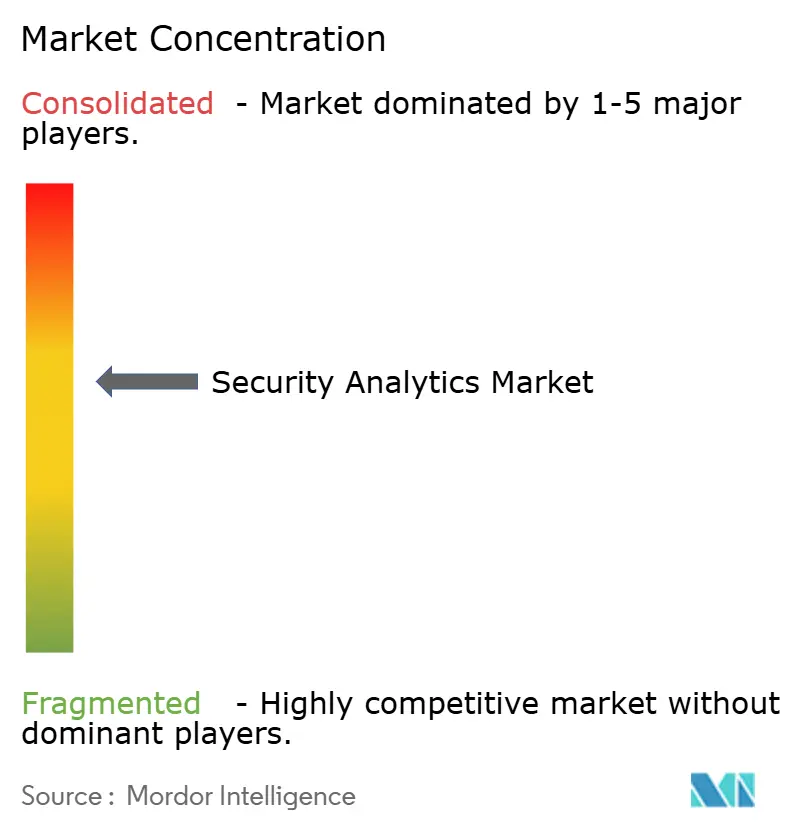
Recent Industry Developments
- June 2025: Fortinet unveiled an AI-powered workspace security suite securing email, browsers, and collaboration tools.
- May 2025: Palo Alto Networks posted 15% y/y revenue growth and 34% ARR surge in next-generation security.
- May 2025: KDDI and NEC formed a joint cybersecurity venture targeting supply-chain and infrastructure clients.
- April 2025: Aurascape launched with USD 50 million to secure AI application pipelines.
Research Methodology Framework and Report Scope
Market Definitions and Key Coverage
Our study defines the security analytics market as all software platforms and related services that collect, normalize, correlate, and visualize security telemetry from networks, endpoints, users, cloud, and applications in order to surface actionable threat insights and automate response workflows.
Scope exclusion: stand-alone managed security service provider (MSSP) revenue that is not bundled with an analytics platform is kept outside the market boundary.
Segmentation Overview
- By Application
- Network Security Analytics
- Application Security Analytics
- Web Security Analytics
- Endpoint Security Analytics
- Cloud Security Analytics
- Insider Threat Analytics
- By Deployment Mode
- On-Premise
- Cloud
- Hybrid
- By Organization Size
- Large Enterprises
- Small and Medium Enterprises
- By End-user Industry
- Banking and Financial Services
- Healthcare
- Defense and Security
- Telecom and IT
- Retail and E-Commerce
- Manufacturing
- Government
- By Geography
- North America
- United States
- Canada
- Mexico
- Europe
- United Kingdom
- Germany
- France
- Italy
- Spain
- Russia
- Rest of Europe
- Asia-Pacific
- China
- India
- Japan
- South Korea
- Australia
- Rest of Asia-Pacific
- South America
- Brazil
- Argentina
- Rest of South America
- Middle East and Africa
- Middle East
- Saudi Arabia
- United Arab Emirates
- Turkey
- Rest of Middle East
- Africa
- South Africa
- Nigeria
- Rest of Africa
- Middle East
- North America
Detailed Research Methodology and Data Validation
Primary Research
Mordor analysts interviewed SOC leaders, security architects, and procurement heads across North America, Europe, and Asia-Pacific to validate price corridors, typical log-ingestion volumes, and penetration rates among large enterprises and mid-market firms. Follow-up surveys with tool integrators helped adjust service attach ratios and cloud migration timelines that secondary sources left unclear.
Desk Research
We begin by mapping the universe of threat-detection tools through public sources such as NIST's National Vulnerability Database, US-CERT advisories, ENISA threat reports, and ITU's ICT statistics, which establish baseline incident volumes, device counts, and regulatory triggers. Company filings, 10-Ks, and investor decks of listed cybersecurity vendors reveal average selling prices and seat counts, while trade association portals such as FIRST and Cloud Security Alliance detail deployment shifts toward XDR and cloud SIEM. Subscription databases owned by Mordor analysts, including D&B Hoovers for company financials and Dow Jones Factiva for deal flows, complement these open datasets. This list is illustrative; many other repositories were reviewed to cross-check figures and definitions.
Market-Sizing & Forecasting
A top-down reconstruction that links reported global cyber-incident counts with average analytics spend per incident sets the initial demand pool, which is then corroborated through bottom-up vendor revenue sampling and channel checks. Key variables in the model include security incident frequency, average log-storage volumes, cloud workload share, mean analyst cost per alert, regulatory compliance deadlines, and regional GDP growth. Multivariate regression with scenario analysis projects these drivers to 2030, and gap-filled bottom-up estimates (for privately held vendors) are aligned to the top-down baseline before finalization.
Data Validation & Update Cycle
Outputs are stress-tested against independent indicators, anomaly flags are re-checked with interviewees, and a senior analyst signs off only after discrepancies fall within preset thresholds. Reports refresh each year, and material events such as large mergers or major breach spikes trigger interim updates.
Why Mordor's Security Analytics Baseline Commands Confidence
Published values differ because firms pick dissimilar scopes, price assumptions, and refresh rhythms.
Mordor's disciplined inclusion of service attach revenue and its yearly primary-source refresh minimize hidden gaps.
Benchmark comparison
| Market Size | Anonymized source | Primary gap driver |
|---|---|---|
| USD 19.40 B (2025) | Mordor Intelligence | - |
| USD 13.49 B (2024) | Global Consultancy A | Counts only solution licenses, leaves out professional and managed analytics services |
| USD 15.17 B (2024) | Industry Research Firm B | Projects via straight-line CAGR without fresh vendor interviews and assumes constant USD index |
The comparison shows that when service revenue, currency alignment, and incident-weighted drivers are fully considered, Mordor delivers a balanced, transparent baseline that decision-makers can retrace and reproduce with confidence.
Key Questions Answered in the Report
What is the current value of the security analytics market?
The security analytics market stands at USD 19.40 billion in 2025 and is projected to climb to USD 48.89 billion by 2030.
Which application segment grows fastest in security analytics?
Cloud security analytics is the fastest, registering a forecast CAGR of 17.6% through 2030.
Why are SMEs adopting security analytics rapidly?
Cloud-delivered platforms lower upfront costs and automate oversight, enabling SMEs to access enterprise-grade protection without dedicated SOC teams.
Which region will see the highest growth rate?
Asia-Pacific is expected to post a 13.8% CAGR on the back of accelerated digitalization, cyber-insurance uptake, and regulatory focus.
How are vendors addressing the SOC talent gap?
Suppliers integrate AI-driven triage, natural-language playbooks, and managed detection services to ease reliance on scarce in-house analysts.
What impact will data-sovereignty laws have on deployment models?
Vendors are deploying regional data centers and edge analytics nodes to comply with residency mandates while sustaining real-time threat detection.
Page last updated on:
